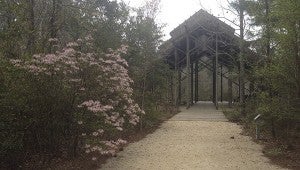Spring now in full swing at the Arboretum: Hang on for the ride!
Published 7:00 am Saturday, April 5, 2014

PHOTO OP: The pink blooms on the honeysuckle azalea (Rhododendron canescens) located near the Pinecote Pavilion make it a popular subject for photographers. This narrow deciduous azalea bears fragrant, funnel-shaped, white, pink, or deep rose flowers. It grows to 15 feet tall and 5 to 6 feet wide.
Photo by Pat Drackett
By Patricia Drackett
Director, Crosby Arboretum/ MSU Extension
What a wonderful time of year to take a walk outdoors! We’re in the midst of those incredible few weeks each spring when dramatic changes are occurring in the appearance of our local plants as their leaves and buds unfurl.
Some of the plants lining our Visitors Parking Lot have really been “showing off.” On a drive through this area you’ll find native pink honeysuckle azaleas growing along the perimeter. If you think these are spectacular, come inside to see the large azalea located on the edge of the main walk to the Pinecote Pavilion.
Also currently blooming in the front parking lot, as well as along area roadsides and forest understories is the elegant parsley hawthorn (Crataegus marshallii). This small native tree is a top performer when either tucked into your woodland edge plantings or used as a flowering specimen. With its delicate, parsley-shaped leaves, exfoliating textured bark, sculptural form, and bountiful blossoms, it is truly a tree for all seasons.
Although parsley hawthorn makes a beautiful accent tree in your home landscape, take care when locating them in your yard as they do have thorns (a boon for the wildlife garden as the trees offer excellent sites for busy birds engaged in nest-building). However, their well-rounded contribution to your landscape may cause you to quickly forgive this characteristic.
A current stunner in the front parking area is the pink-flowering native crabapple (Malus angustifolia). Last week, I was encouraged by long-time Arboretum associate, Jean Hartfield, to offer my profuse apologies to the readers of this column for neglecting to point out the delicious fragrance of this spring-bloomer, along with that of horsesugar (Symplocos tinctoria). I also neglected to mention that horsesugar’s other common name is yellowwood, because of the yellow dye that early settlers obtained from boiling the bark and leaves of this tree.
Jean was right, of course. It’s not enough that Southern crabapple is a drop-dead gorgeous performer in your landscape, and a generator of tasty fruit favored by wildlife, but one of its finest attributes is sweet-smelling blooms. Yes, the scent of both the crabapple and horsesugar is remarkable, and last week I got carried away in describing the other plants and discovered I had run out of room to mention some of the other striking characteristics of these two species.
The fragrance of Southern crabapple can be appreciated from a distance, such as across our parking lot, being wafted by the breeze, or right up close. Walk “inside” and stand among the branches to watch happy insects working the flowers. On a blue day, the juxtaposition of azure skies and pink blossoms is unequaled. Perhaps from this you will be inspired to plant a fragrance garden, beginning with these two native species.
Join us for a field walk on the Arboretum grounds on Saturday, April 5 at 10 a.m. Ask questions, and learn more about the native wildflowers and other plants blooming this time of year, and how to incorporate them into your home landscape. The program is free to members and $5 for non-members.
A program on “Home Landscaping with Native Plants” will be held on Saturday, April 12 from 10:00 to 11:00 a.m. Learn how to have a low-maintenance and attractive home landscape using Mississippi native plants with Arboretum director Pat Drackett. Program is free to members and $5 for non-members.
Mark your calendars for the Arboretum’s annual Strawberries and Cream Festival on Sunday, April 13 from 1 to 3 p.m. Bring the family and join us to celebrate the history of the old strawberry farm on the lovely Pinecote Pavilion. Ice cream, fresh strawberries, and Picayune Frog Lemonade will be served. Admission is free and open to the public.
A very special event at Strawberries and Cream will be the debut of former Arboretum curator Bob Brzuszek’s new book on the Crosby Arboretum. Bob will be at the event to sign copies of “The Crosby Arboretum: A Sustainable Regional Landscape,” (LSU Press).
For more information or to sign up for a class, call 601- 799-2311. The Arboretum is open Wednesday through Sunday from 9 a.m. to 5 p.m. and located in Picayune, off I-59 Exit 4, at 370 Ridge Road (south of Walmart and adjacent to I-59).
For further exploration:
Read more about parsley hawthorn by entering this plant into the search engine at the Extension Service website (www.MSUcares.com) to find articles about this beautiful native tree.




